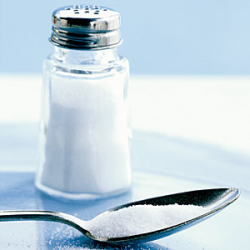Adults around the World Consume Double the Recommended Intake of Sodium
 Do most adults eat too much salt? According to research presented at the American Heart Association's Nutrition, Physical Activity and Metabolism and Cardiovascular Disease Epidemiology and Prevention 2013 Scientific Sessions, the answer is an overwhelming "Yes."
Do most adults eat too much salt? According to research presented at the American Heart Association's Nutrition, Physical Activity and Metabolism and Cardiovascular Disease Epidemiology and Prevention 2013 Scientific Sessions, the answer is an overwhelming "Yes."
Evidence presented at the seminars showed that 75 percent of the world's population are consuming almost twice the daily recommended amount of sodium.
In 2010, sodium intake from commercially-prepared food, soy sauce, table salt and salt added during cooking averaged nearly 4,000 milligrams a day globally.
The World Health Organization (WHO) advises limiting sodium to less than 2,000 milligrams a day. The American Heart Association recommends people limit their sodium intake even more, to less than 1,500 milligrams daily.
Lead author of the study Saman Fahimi, M.D. said, "This study is the first time that information about sodium intake by country, age and gender is available. We hope our findings will influence national governments to develop public health interventions to lower sodium."
Cardiovascular disease has become the number one cause of death in the world. Excess sodium consumption raises a person's blood pressure, with high blood pressure being one of the major contributors to the development of cardiovascular disease.
Average sodium intake exceeded healthy levels in both women and men in nearly all countries, the researchers said. The highest sodium intake was in Kazakhstan with 6,000 milligrams per day, closely followed by Mauritius and Uzbekistan with slightly less than that daily amount.
The lowest average intakes were found in Kenya and Malawi with average sodium consumption of 2,000 milligrams per day. Average intake in the U.S. was about 3,600 milligrams daily.
Representing 99 percent of the world's population, 181 of the world's 187 countries were evaluated in the study and found to exceed WHO's recommended sodium intake of 2,000 milligrams per day. Only Kenya stayed lower than the American Heart Association's recommended sodium intake of less than 1,500 milligrams per day.
The sodium intake of adults from 247 surveys was used for the research. The studies took place between 1990 and 2010 as part of the 2010 Global Burden of Diseases Study, an international collaborative by 488 scientists from 303 institutions in 50 countries around the world.
Posted in Adults around the World Consume Double the Recommended Intake of Sodium
Ask a Question Or Join a Discussion


